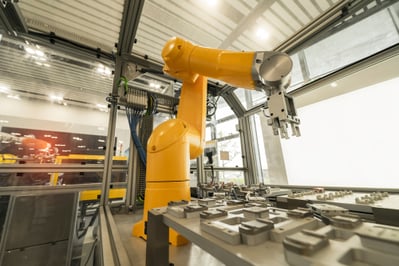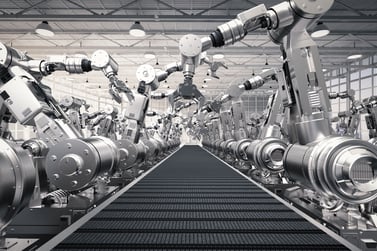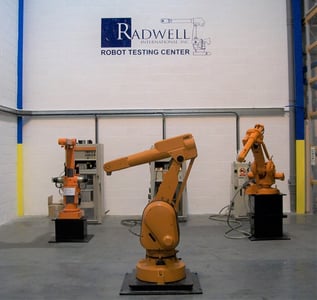Smart Manufacturing: The Autonomous Future of Industry
It was in the sphere of manufacturing that robots first made the leap from flights of science fiction fantasy and early experimental designs, to fully realised, practical tools. Unimate, an industrial robot developed by Joe Engelberger and George Devol, began its career at the General Motors plant in Ewing, New Jersey way back in 1961, carrying out step-by-step pre-programmed tasks on an automotive assembly line. This was the beginning of a revolution in manufacturing.
Over half a century later, similar robots are still an important fixture on assembly lines and in manufacturing plants across the world, saving time, money, and effort during the process of assembly, and increasing accuracy and safety in the process.
However, from a conceptual point of view, these robots are drastically different from their predecessors on the production line. Today's robots are far more sophisticated and capable of performing more complex tasks than was ever previously thought possible. What's more, there has been a fundamental shift in focus for robotics developers, away from programmed systems towards something more intelligent - something capable of learning and developing autonomously.
This is where artificial intelligence is going to play a major part in the next phase of robotic manufacturing. If we can craft systems that are genuinely intelligent - displaying understanding of role and purpose within a broader operation - then the robotic machinery that these systems support will become far more active, far more versatile, participants in industry. Rather than having to be painstakingly programmed to handle each and every task, the robot will develop skills on its own, or through training, which can then be transferred to other areas of operation. The age of smart manufacturing will begin in earnest.
However, there is a problem here. Artificial intelligence, both as a concept and as a practical technology, is still in its relative infancy. The machines and systems which exhibit what we consider artificial intelligence are in fact only operating at AI Tier II - the Limited Memory phase of AI development.
At Tier II, systems store evidence of their experiences within their memory, similar to the way in which we humans empirically learn from the world around us. This is a step up from Tier I systems, which are capable only of reacting directly to stimuli in a pre-programmed manner. While this can still be considered artificial 'learning' - the system is adding to its experience up to the limits of its information storage capabilities, after all - it is still some distance from 'understanding' and becoming 'self-aware', two functions which remain beyond the reach of modern robotics and AI.
This is not to say that smart manufacturing is not already possible within the current bounds of AI technology. Electronics firm Siemens has already developed artificially intelligent robot equipment which behaves in an 'autonomous', rather than in an 'automatic', fashion, and are putting this to work within their showcase Amberg plant in Germany.
The team at Siemens identified how the strength of a traditional automated system is also the shortcoming of the technology. Robotics has already proved adept at repeating the same process over and over again, manufacturing the same component quickly, economically, and at an enormous volume. But this ability to repeat the same function after an initial phase of programming is of no use to smaller scale manufacturing jobs, in which many different components must be produced at a small volume - often referred to in the industry as Batch Size 1.
 At Batch Size 1, a piece of robotic equipment would need to be programmed ahead of time, enabling it to complete the task in hand. On completion, it would then need to be reprogrammed for the next task, and so on and so forth, ad infinitum. Pre-programming in this manner is a time-consuming task, and repeating the programming phase for each new small job is simply not cost-effective. Even if all of the sequential tasks could be programmed into the robot's memory ahead of time, the machine would still need to 'understand' which part of the job it was currently working on, adjusting its function accordingly, and increasing the potential for error. This would also leave no possibility for learning transferable skills to be used on other jobs in the future.
At Batch Size 1, a piece of robotic equipment would need to be programmed ahead of time, enabling it to complete the task in hand. On completion, it would then need to be reprogrammed for the next task, and so on and so forth, ad infinitum. Pre-programming in this manner is a time-consuming task, and repeating the programming phase for each new small job is simply not cost-effective. Even if all of the sequential tasks could be programmed into the robot's memory ahead of time, the machine would still need to 'understand' which part of the job it was currently working on, adjusting its function accordingly, and increasing the potential for error. This would also leave no possibility for learning transferable skills to be used on other jobs in the future.
But at Siemens, a team headed by Kai Wurm and Georg von Wichert has come up with a solution to this problem. They have developed a system which will be able to work in the autonomous manner described above, with no need for pre-programming, instead reacting to instructions delivered directly from the operator. This might seem like a regression to Tier I on the AI development spectrum, but consider this for a moment: the tasks that the robot will be completing are incredibly complex, and require a thorough understanding of the aims and objectives of the job at hand. This is not merely reacting to an encountered stimuli; this is interpretation and recognition of instructions delivered, and the translation of these instructions into movements and actions which have been autonomously decided on.
Direct evidence for this can be found deep in the mechanical function of the machine itself. If a component is located near the left arm of the machine, it is this arm which picks the component up and begins the process. However, it may be that the right arm is better positioned to attach the component in the right way during assembly, in which case the left arm will pass the component to the right appendage. This is something which would not be possible from purely reactive AI.
What we are seeing here is interpretation. The machine receives the specifications of its instructions and then uses these to construct a program which will enable it to complete these instructions and achieve the necessary objectives. Rather than pre-programming the machine for each new task, however small, the autonomous system will be able to handle the entire process itself, greatly increasing efficiency and effectiveness across the board.
 So what does this mean for manufacturing here in the United Kingdom, as well as further afield? Martin Thomas, European Marketing Manager at Radwell International Ltd explains more.
So what does this mean for manufacturing here in the United Kingdom, as well as further afield? Martin Thomas, European Marketing Manager at Radwell International Ltd explains more.
“The first and arguably most obvious benefit is to manufacturing firms themselves, specifically in the ways in which they are able to complete tasks on either a large or a small scale. These firms will find their corporate agility is greatly increased, as they are able to complete orders with minimal advance notice, to a high degree of accuracy and quality. The cost and risk of the process will also be improved. These advantages will then be passed on to the consumer in terms of more advantageous pricing and increased accessibility to truly life-changing technology.”
This element was at the heart of a report issued by the UK Government's Office for Science, which described how the future of UK's manufacturing industry must align with the needs and expectations of the general public.
“Sustainability is another key benefit. As we look to the future, the challenges facing us as a species are evolving. It is up to us to find the most resource-efficient means to craft the technological solutions of tomorrow, enabling us not only to conserve and protect resource supplies on Earth, but also to effectively develop revolutionary technological solutions which enable us to live in better harmony with nature and the environment.”
 “As manufacturing technology evolves, the workforce will need to develop also in order to keep pace. Traditional roles will be replaced by supervisory positions, and other positions associated with the maintenance and upkeep of machinery. Anxiety surrounding direct unemployment as a result of smart robotics should prove to be unfounded, as the shifting landscape will lead to the creation of other jobs to take the place of traditional, manual, production line tasks.”
“As manufacturing technology evolves, the workforce will need to develop also in order to keep pace. Traditional roles will be replaced by supervisory positions, and other positions associated with the maintenance and upkeep of machinery. Anxiety surrounding direct unemployment as a result of smart robotics should prove to be unfounded, as the shifting landscape will lead to the creation of other jobs to take the place of traditional, manual, production line tasks.”
“We may not yet have two feet placed squarely in the age of smart manufacturing and autonomous systems, but we are standing at its precipice. What comes next promises to be perhaps the most exciting chapter in the history of manufacturing to date. Radwell’s own Robot testing capabilities are continually enhanced and our repair technicians keep up to date with the latest technological developments to ensure we can better serve our customers who are investing in these smarter, artificial and autonomous advancements.”








